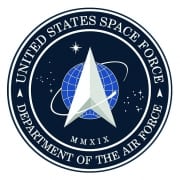The United States Space Force
By Herb Rosenbleeth
The U.S. military now has another branch. The United States Space Force (USSF) is now the sixth branch of the U.S. military. It is the newest armed service since the establishment of the U.S. Air Force in 1947. I had a cousin who served in the Army Air Corp in World War II and remember him becoming a member of the U.S. Air Force when it was created.
Like the U.S. Marine Corps falls under the Secretary of the Navy, the U.S. Space Force will fall under the Secretary of the Air Force, who heads up one of the three military departments within the Department of Defense.
The mission of the U.S. Space Force is to “organize, train, and equip space forces in order to protect U.S. and allied interests in space…” The responsibilities of the U.S. Space Force include developing military space professionals, acquiring military space systems, maturing the military doctrine for space power, and organizing the space force to present to the Combat Commands.
For now, the 16,000 active duty airmen and civilians who work at Air Force Space Command will be assigned to the Space Force. Eventually, members of the Army and Navy will also be detailed to the Space Force. The Space Force will establish independent procedures for manning equipment, training personnel, and creating a new uniform, logo, patch, and official song. The Air Force Space Command (AFSPC) has been assigned to control operations and the Space and Missile Systems Center, which is responsible for research and acquisitions.
The idea of an independent service for U.S. military space operations has been under consideration since 2001. Secretary of Defense Donald Rumsfeld chaired the 2001 Space Commission, which was created to examine the national security space organization of the United States.
The commission concluded that the military needed to develop a space specific doctrine, including the development and deployment of space-based weapons. The Space Commission concluded that the Air Force treated space operations as a secondary mission to air operations.
In 2017, following nearly two decades of inaction, Representatives Mike Rogers and Jim Cooper put forth a bipartisan proposal to create the U.S. Space Corps. The proposal cleared the House, but not the Senate.
Then, in a June 2018 meeting of the National Space Council, the Department of Defense was directed to establish the U.S. Space Force as a branch of the Armed Forces. On February 19, 2019, Space Policy Directive-4 was signed. Legislative provisions for the Space Force were included in the 2020 National Defense Authorization Act, which was signed into law on December 20, 2019. Air Force General John “Jay” Raymond became the first Chief of Space Operations. Although it took three years to get the Air Force formed after its establishment in 1947, the U.S. Space Force intends to be off and running in 18 months or less.
Secretary of Defense Mark Esper believes the first shots in the next war will be fired from space. At the Reagan Forum on December 7, Air Force Chief of Staff General David Goldfein said that China’s number one threat to the U.S. is space attack.
There are several ways the U.S. can be attacked. These include bumping a U.S. satellite, jamming their links, hitting our satellites with laser beams, hitting them with high-power microwave bursts, and command intrusion.
JWV will be a strong supporter of the U.S. Space Force.
Volume 74. Number 1. 2020




